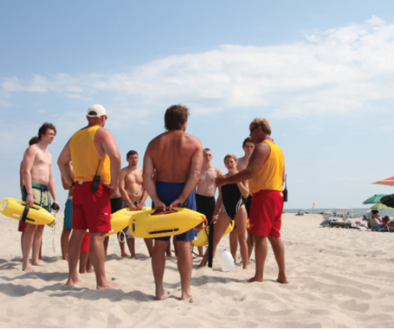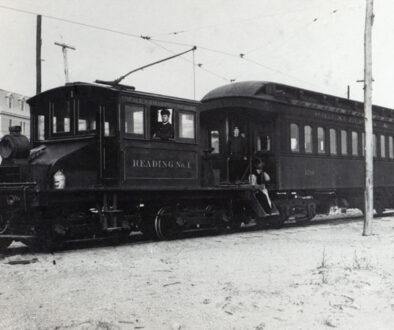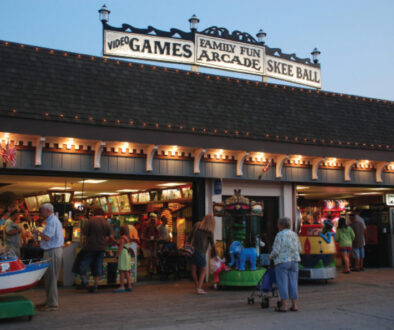In the beginning

Forty-two years ago, God visited the Mainstay Inn.
Well, it wasn’t actually the Supreme Being, and it wasn’t quite the Mainstay Inn, at least not the one that stands proudly on the intersection of Columbia Avenue and Stockton Place now.
But back in the early 1970s, the self-appointed deity of the bed-and-breakfast industry was one Norman T. Simpson. At the time, there were only a handful of B&B’s in the United States, and in Cape May there was only one: the Mainstay, then at 24 Jackson Street. Starting in 1966, Simpson launched a peripatetic, nonstop journey across New England and the Mid-Atlantic states looking for charming places to stay, and he started compiling them into a book—at first, really, just a pamphlet—called Country Inns and Back Roads. Its first edition, in 1966, included just twelve properties, all in New England, and not all of them could truly be called B&B’s—some were just quaint, well-appointed guest houses and inns. Still, Simpson was onto something, and when he showed up at the Mainstay in 1973, he caused quite a stir.
“You would think we were receiving God when he came to our place,” recalls Tom Carroll, who along with his wife, Sue Carroll, created the Mainstay, Cape May’s first real B&B, in 1972, in a stately Victorian mansion at 24 Jackson Street. “It was off-season, and the awnings were down, but we ran around putting them back up.” The Carrolls anxiously showed Simpson around, and they were rewarded when the Mainstay was included in the next edition of Country Inns and Back Roads. The book was growing in size, as B&Bs and other small inns slowly began to gain popularity in the 1970s. (Eventually Simpson’s book expanded to five hundred pages.) And if Simpson was “God,” Country Inns was the Bible of the early B&B movement. “When you got into the book, you were ‘anointed,’” says Jay Karen, executive director of Select Registry, a nationwide association of B&B’s, which evolved from an organization that Simpson founded thirty years ago called the Independent Innkeepers Association.
It’s a familiar story now. From only a handful here and there, B&B’s grew enormously in popularity. “B&B’s really started to take off in the 1980s,” says Heather Turner, interim marketing director for the Professional Association of Innkeepers International (PAII). “Back in the 1970s, I don’t know that there were that many of them out there.” By the end of the decade, though, there may have been as many as a couple of thousand, she estimates. The explosion would come after that, and by the 1990s there were as many as 20,000 B&B’s, country inns, and mini-hotels nationwide. And the Carrolls, along with Simpson and a small coterie of pioneers, led the way.
In 1977, the Carrolls sold their original B&B – it’s now the Windward House, run by Sandy Miller and her son, Owen Miller – and purchased the majestic house at 635 Columbia Avenue and dubbed it, too, the Mainstay. Built in the 1870s and long used as a gentleman’s club and gambling den, it had fallen into disrepair. The Carrolls purchased it for $125,000. Painstakingly restoring, furnishing and decorating it, and taking advantage of its exquisite design and fourteen-foot ceilings, they it turned it—along with a cottage next door and a former naval officers’ club across the street, later on—into one of Cape May’s premier Victorian B&B’s. The Mainstay was soon joined by Captain Mey’s, the Duke of Windsor, the Queen Victoria and others, recalls Tom Carroll. But at first, adds Sue Carroll, “In Cape May, there weren’t any others.”

The fledgling B&B movement of the early and mid-1970s was led by a handful of people who met often, shared ideas, and learned from each other. “We had many, many people who came and stayed with us, and asked hundreds of questions, and took what they learned back home,” says Sue. “And we went to stay at other places. We would steal their ideas!” Before long, the Carrolls were running an informal community college for would-be B&B owners that they called the Inn Deep workshop. “It was really a school on how to become a B&B innkeeper,” says Tom. “We peaked at about a hundred attendees by the early 1990s.” That’s when the number of B&B’s in Cape May peaked, too, reaching something like 75 to 80 in Cape May alone, recall the Carrolls.
One of the biggest challenges for Cape May’s early B&B innkeepers was that the town opened for business on Memorial Day and shut down tight as a drum on Labor Day. In the 1970s, Cape May had no jazz festival, no singer-songwriter festival, no Victorian Christmas, no arts festivals, no Cape May Stage or East Lynne Theater Company, no Mid-Atlantic Center for the Arts. “You could lie down in the middle of Columbia Avenue in the middle of September and stay there for hours,” laughs Tom.
To remedy that, the Carrolls started what was one of the first organized efforts to bring tourists to Cape May in the off-season by contacting bicycle clubs and offering them weekend packages at the Mainstay. Soon enough, the Potomac Peddlers, the Harrisburg Bicycle Club, the Baltimore Bicycle Club and others came en masse to Cape May in the spring and fall. They did the same thing with stamp collectors and photography clubs. Others started coming up with similar ideas, too. “Joan and Dane Wells of the Queen Victoria [which opened in 1980] singlehandedly started the idea of Victorian Christmas in Cape May,” says Sue. By 1989, the New York Times would call Cape May “the national leader in the number of Victorian bed and breakfast inns.”
The Carrolls owned and operated the Mainstay from 1977 to 2004. Having expanded to encompass the cottage next door and the former naval officers’ club across the street, they sold the Mainstay for $4 million to David and Susan Macrae, who in turn sold it—minus the officers’ quarters—to Pete and Esther Scalone for $2.5 million. All along, it’s been maintained to exacting standards by its caretakers, and managed by Diane Clark, who’s been the on-site innkeeper for the Carrolls, the Macraes, and now the Scalones for 28 years. “Basically, everything has stayed the same, and luckily all of the owners haven’t made any big changes to the building,” says Clark. “My fear all along was that somebody would buy the place and really mess with it.”
Why has she stayed on so long? In part, because it feels like home, says Clark, who grew up in Cape May and attended Cape May Elementary School and Lower Cape May Regional High School. “I would say that what keeps me here are the guests. It’s like, if I were to leave, I wouldn’t see so-and-so. We do things together.” Many of the guests have returned year after year, for decades. And Clark is very close to the staff, adding that she coached Tracy Molson, assistant innkeeper, in Little League softball . “We’re almost like a little family here,” says Clark.
The Scalones, who are still getting used to the idea of owning the Mainstay, say without knowing that they could count on Clark’s deep knowledge and skills they wouldn’t have considered buying it. “We couldn’t do it without Diane,” says Esther Scalone. “Diane and the staff are what make it work. I don’t even know how to make coffee! I’m a tea drinker.” (Esther, who is Irish, may prefer tea over coffee. But Pete Scalone says, “Esther and her love of tea is our secret weapon,” since a major feature of the Mainstay’s daily routine is an ample, British-style tea at four o’clock.)
For the most part, the Scalones have kept the Mainstay in its original, restored condition, and they plan to keep it that way. Over the years, of course, from the 1980s onward, there have been upgrades: televisions, air conditioning, and an Internet connection among them. Other changes, says Pete, may be less visible to guests, such as improvements to the electrical system or ductwork. But it’s also true that many guests don’t want to see things change at all. “Generally,” he says, “if we were to consider making big changes, the pitchforks would come out. ‘Don’t touch it!’ they’d say.” In fact, some traditional-minded guests have requested that televisions be removed during their stay. “A lot of guests don’t want a TV,” says Esther. “They come for the Victorian experience. They sit on the porch and watch the carriages go by.” Adds Pete: “They want to go back in time.”
Still, for all that, the bed-and-breakfast industry in Cape May has been declining for years from its peak in the 1990s. One after another, B&B’s are being sold off and converted into private homes or whole-house, seasonal rentals. According to the Carrolls and the Scalones, and to the folks at PAII and Select Registry, there are plenty of reasons why: those who bought B&B’s decades ago are aging out of the business and want to retire, but after the 2008-2009 economic downturn real estate values have fallen and they might feel like they can’t get the price they’d hoped for, so they’re opting for the whole-house rental idea in the hope that values climb higher in years to come.
Also, many people now travel in multi-generational groups, says Sue Carroll, “and it’s a lot cheaper to rent a house than to rent, say, eight B&B rooms.” Another factor putting pressure on B&B’s is that since the downturn in the economy, older folks might see a B&B stay as an unaffordable luxury. “We had loads of midweek senior citizens staying with us, but I don’t know that they have money like that anymore,” says Sue. Innkeepers say that most of their guests fall into the range of people between 30 and 60, usually looking for a romantic getaway. (One study, by Michigan State University, found that only nine percent of B&B guests were over 59 years old.)
And certainly some B&B’s overdid it to decorative excess. “Some went overboard with teddy bears and lace and stuff all over, so you couldn’t even find a place to put things down,” laughs Sue Carroll. Taking note of efforts to counter that trend, the Wall Street Journal reported that for most inns today “the term ‘bed and breakfast’ is no longer code for teddy bears, floral bedspreads and doilies.” Still, says PAII’s Turner, “There’s still that, I call it, the ‘doily mentality,’ that B&B’s are associated with fuddy-duddy grandmas.”
Yet the Mainstay, still as popular as ever, has avoided all of the pitfalls, and it’s going strong. On a recent warm Tuesday afternoon, Kathi Haywood of Columbus, Ohio, was enjoying afternoon tea on the Mainstay’s luxurious front porch. She’d come to Cape May for a nearby dance competition in which her daughter would participate, and their group was enjoying a choice of eighteen different teas, lemonade and iced tea, veggies and dips, cheeses, and a large array of cookies, brownies and shortbreads. Even on a fairly hot day, the rocking chairs and swings on the sheltered porch beckoned. “We love the history of this place,” she says. “We love the ornate, classical look.” And she’s creating new customers: for her teenage daughter, Kara, it was a first-ever B&B experience.






